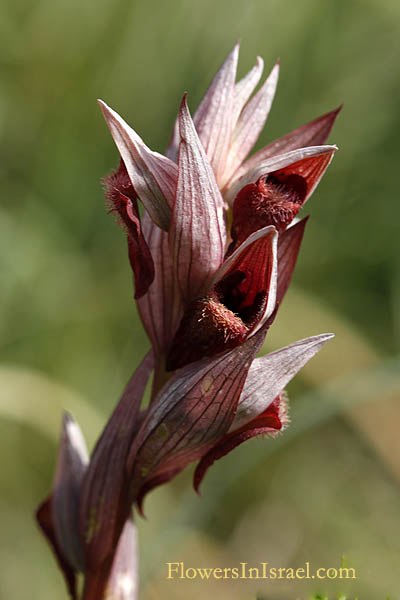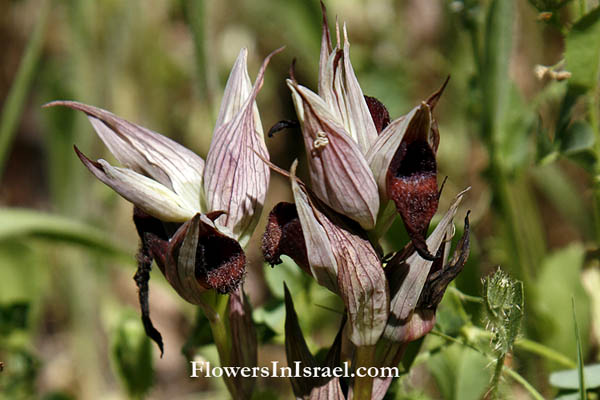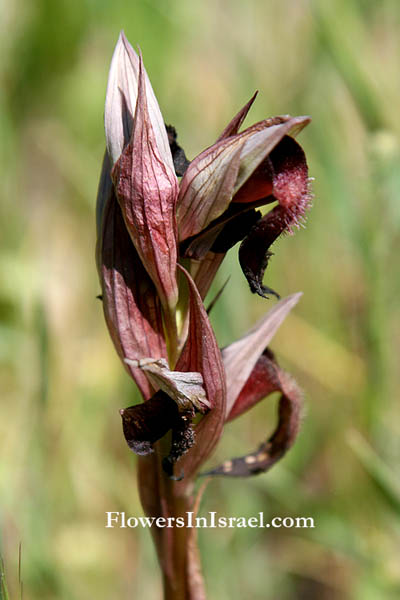Long-lipped Serapias, Ploughshare orchid,
Hebrew: שפתן מצוי, Arabic: سربياس كالمحراث
| Scientific name: | Serapias vomeracea (Burm.f.) Briq. | |
| Synonym name: | Serapias levantina H.Baumann & Kuenkele | |
| Common name: | Snake Tongue Orchid, Long-lipped Serapias, Ploughshare orchid | |
| Hebrew name: | שפתן מצוי | |
| Arabic name: | سربياس كالمحراث | |
| Family: | Orchidaceae, סחלביים |

Location: Bene Zion Nature Reserve |
| Life form: | Geophyte | |
| Leaves: | Alternate, rosette, entire | |
| Flowers: | Auburn | |
| Flowering Period: | March, April | |
| Habitat: | Batha, Phrygana | |
| Distribution: | Mediterranean Woodlands and Shrublands, Montane vegetation of Mt. Hermon | |
| Chorotype: | Mediterranean | |
| Summer shedding: | Ephemeral |

Derivation of the botanical name: Serapias, Latin Serapis, Greek Σάραπις, Sarapis; named after the deity Serapis, an ancient Egyptian god of the lower world. vomeracea, like a ploughshare. levantina, of or pertaining to the Levant (countries on the eastern shores of the Mediterranean Sea). The Hebrew name: שפתן, sfatan, from שפתני, labiate, lipped.
Pollination of Serapias Vomeracea by imitation of holes for sleeping solitary male bees (Hymenoptera). Acta Botanica Neerlandica, Volume 30, Issue 1-2, February 1981, pages 69-73; Article by Amots Dafni, Yariv Ivri, N. B. M. Brantjes, Wiley Online Library. "Pollination occurs when in the afternoon hours the bees waver from flower to flower. The bees finally come to rest on a particular flower and remain there for the duration of the night. In the morning, the bees which slept in the flowers, are warmed up as a result of solar radiation which heats the flowers to 3 ***°C above ambient temperature. Since the males of many Hymenoptera sleep in holes, the hypothesis is that the flowers mimic such holes. The shortness of the flower tube can be held responsible for the observed frequent changes from flower to flower, which is so important for pollination efficiency... The females of these solitary bees usually sleep in their holes in the ground. The hundred males which were found sleeping in a Serapias flower may indicate that to bees, the flowers resemble their holes." Serapias flowers function as holes for Eucera bees and therefore, could be regarded as mimics. The mimic is deceptive because the bee is attracted to the ‘hole’ forms, although the shortness of the tube keeps the bee moving between the flowers. In this way Serapias presents another example of the mimicry capacities of the terrestrial orchids (Dafni & Ivri 1980). Eucera is a genus of bees in the Apidae, subfamily Apinae, and the tribe Eucerini- the long=horned bees. 
|